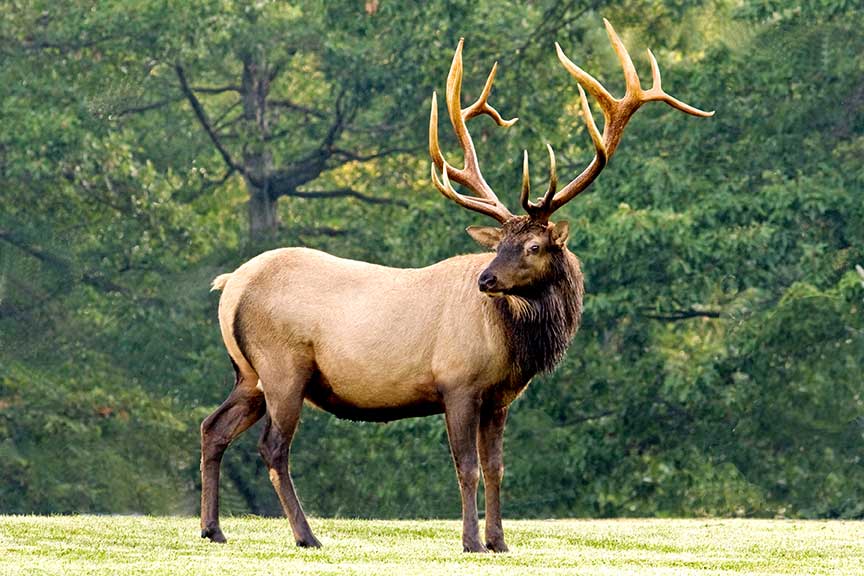Industry Helps Restore Elk to Former Appalachian Range

By Staff, West Virginia Department of Commerce and Division of Natural Resources
Almost anywhere you go in West Virginia or Kentucky, you probably aren’t too far away from a reminder that great herds of elk once roamed the region. In fact, the Elk River flows past the town of Elkview before joining the Kanawha in West Virginia’s capital city of Charleston.
Those herds haven’t been seen in perhaps 200 years. They were wiped out across much of the country. However, the states of Kentucky and West Virginia are working very hard to bring those herds back, and they are using former coal mine lands as their initial reintroduction points.
“Reclaimed land is a great canvas for elk habitat,” said Steven Dobey, the Rocky Mountain Elk Foundation’s (RMEF) eastern conservation program manager. “With a little improvement, elk do just fine. We’ve seen it take place in Kentucky, and I’m sure we’ll see it in West Virginia, too.”
Known as the Wapiti Woods Project, the primary point of introduction in West Virginia for elk restoration has been the Tomblin Wildlife Management Area in Logan County, one of the largest coal-producing counties in the state.
The RMEF says the Tomblin Wildlife Management Area is a great example of how reclaimed mine sites can be transformed into thriving wildlife habitat. The 44,000-acre area includes several former surface mine operations and has rolling grassland and vast areas of forest – perfect habitat for elk and other species.
Here, elk, which disappeared from West Virginia in the 1800s due to timbering and hunting, have been reintroduced and a new herd is growing bigger each year.
By returning abandoned mine sites to a natural state and reintroducing a once native species, the area is attracting newfound attention. Popular elk-viewing tours sell out every fall and the Tomblin Wildlife Management Area has become a popular hunting location – though elk hunting is not currently allowed in West Virginia.
Dobey said the West Virginia project is unique in its potential impact due to the cooperation and coordination with the coal industry.
“It’s a great project,” Dobey said. “There’s always a lot of fanfare and excitement in the early years of a project like this but we often see long-term positive impacts, particularly in the southern Appalachian region. Just having them back on the landscape is exciting and it’s a huge draw for people to come and watch elk, and that isn’t even touching on the hunting prospect. This opens a whole new door, collectively, and will have a huge financial impact on local economies.”
Dobey pointed to Kentucky as an example of the economic impact an established elk herd can have.
“Our herd is now approximately 13,000 elk,” he said. “We sell between 600 to 1000 elk [hunting] tags each year. Many of those tourists are hunters. Those people come to the state and (spend) thousands of dollars on their trips. They spend several days in Kentucky. Often, they come earlier in the year – prior to hunting season – to scout out their areas, and that provides money to the local economy.”
Dobey said none of this would be possible without the cooperation of the coal industry.
“Elk require open habitat,” he said. “The only place you find that in the Appalachians is on coal properties. Oh, we might introduce some elk, but it wouldn’t be successful without partnerships with the coal industry.”
Elk herd restoration is just one of many ways states are making use of former mine land. Some are building parklands, recreational areas, residential areas and agriculture. These new uses boost local economies by attracting tourists, raising the value of neighboring properties and protecting important natural resources.
The rugged terrain and remote locations of some former mine sites make conventional redevelopment difficult, but reclamation doesn’t have to be prohibitively expensive. Thanks to the United States Office of Surface Mining Reclamation and Enforcement’s Abandoned Mine Land Program, millions in grants are awarded to coal-producing states each year to reclaim former mine lands.
In 2020, West Virginia will receive $22.8 million through the program, which helps fund economic development projects near mine sites that ceased operations before the signing of the Surface Mine Control and Reclamation Act on August 3, 1977. Money distributed through the Abandoned Mine Land Program comes from reclamation fees active mines pay on each ton of coal they produced (28 cents on surface-mined coal, 12 cents on subsurface or deep-mined coal and eight cents on lignite). This money is then distributed to 25 coal-producing states and three Native American tribes based on a formula that considers factors such as historic coal production. West Virginia received $35.7 million, $36.2 million and $23.3 million in 2019, 2018 and 2017, respectively.
Dobey said the Kentucky Department of Fish and Wildlife began the first elk releases in the state in 1997. The active reintroduction project continued through the end of 2002. During that period 1,550 elk were released on eight different sites in the 16-county restoration zone, which included Bell, Breathitt, Clay, Floyd, Harlan, Johnson, Knott, Knox, Leslie, Letcher, Magoffin, Martin, McCreary, Perry, Pike and Whitley counties. Elk have since thrived in the state. The original population target of 7,400 elk was achieved in 2008, approximately 11 years ahead of schedule, and now totals more than 13,000.
The Kentucky herd has been the source herd for several elk restoration efforts in other states, including Missouri and Virginia. West Virginia received its elk from Arizona and Wyoming and Kentucky – with most coming from Arizona.
Amber Munig, big game program supervisor for the Arizona Game and Fish Department, said discussions about the reintroduction program began in 2016, with the first animals being shipped to West Virginia in January 2018.
Munig said about 52 elk were rounded up in the backcountry of Arizona in 2018 and kept in quarantine for 30 days, while they were tested for diseases, before being shipped to West Virginia, where they were also quarantined for another 60 days. She said it was a pleasure to help West Virginia.
“Our native herds were also killed off in the mid-1800s,” Munig said. “We got ours from Yellowstone in the early 1900s, and it’s always amazing to help restore animals to other areas.”








